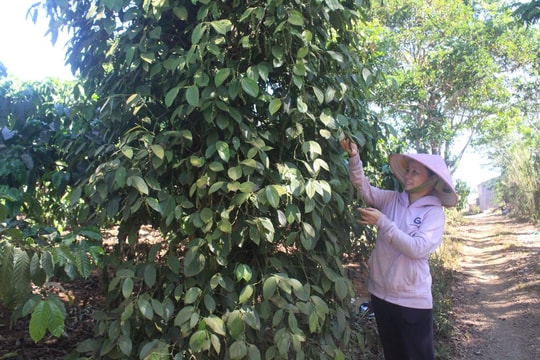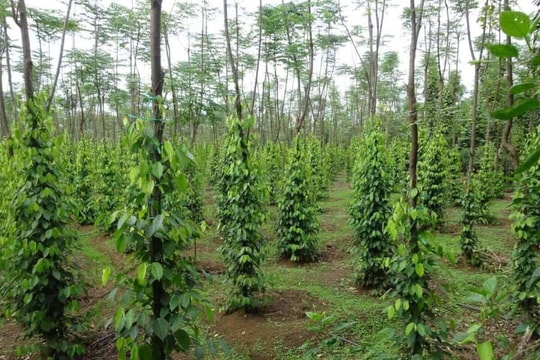Pepper price today March 4, 2025: Slight increase in Dak Nong
Today's domestic pepper price, March 4, is at 157,000 - 159,200 VND/kg. A slight increase of 200 VND/kg in Dak Nong compared to yesterday. Currently, Dak Nong is the province with the largest pepper growing area in the country.
Domestic pepper prices today
The highest pepper purchase price in key pepper growing regions (Dak Lak, Lam Dong, Gia Lai, Dak Nong, Ba Ria - Vung Tau, Binh Phuoc) was recorded at 159,200 VND/kg.
Specifically, in Dak Nong province, pepper price is at 159,200 VND/kg. A slight increase of 200 VND/kg compared to yesterday.
In Gia Lai, pepper price is 157,000 VND/kg. Unchanged compared to yesterday.
In Dak Lak, pepper price is 159,000 VND/kg. Unchanged compared to yesterday.
In Binh Phuoc and Dong Nai, pepper price today is at 158,000 VND/kg. Unchanged compared to yesterday.
In Ba Ria - Vung Tau, pepper price today is at 157,000 VND/kg. No change compared to yesterday.
Thus, today's pepper price in the domestic market is currently at its lowest price of 157,000 VND/kg.

In Dak Nong, after the Tet holiday, farmers are preparing to enter the harvest season. This year's pepper prices have shown many positive signs, bringing hope for a bumper crop. Dak Nong is currently the province with the largest pepper growing area in the country. In addition to maintaining output, the locality is promoting the application of high technology in production in key areas.
In recent years, pepper cultivation in Dak Nong has undergone many positive changes, moving towards organic models and developing sustainable ecosystems. Notably, Dak Nong pepper has geographical indications, helping to increase the value of the product.
In the future, farmers need to apply farming methods according to safety standards and limit pesticides to ensure quality and meet export requirements.
World pepper prices today
In the world market, based on quotes from export enterprises and export prices in various countries, the International Pepper Association (IPC) updated the prices of all types of pepper traded in the international market on March 4 (local time) as follows:
The price of Indonesian Lampung black pepper increased again compared to yesterday to reach 7,300 USD/ton (up 0.89%). In addition, the price of Muntok white pepper also increased slightly compared to yesterday to reach 10,136 USD/ton (up 1.75%).
Brazilian black pepper ASTA 570 price remained unchanged from yesterday at USD 6,850/mt.
Malaysia’s ASTA black pepper price is stable compared to yesterday at USD 9,700/ton. In addition, the country’s ASTA white pepper price is also stable compared to yesterday at USD 12,200/ton.
Prices of all types of Vietnamese pepper remained unchanged compared to yesterday. Of which, the price of Vietnamese black pepper 500 gr/l reached 6,900 USD/ton; 550 gr/l reached 7,100 USD/ton.
Similarly, Vietnam's white pepper price remained unchanged from yesterday at USD 9,900/ton.
Currently, world pepper prices have not changed much, but last week the market moved in opposite directions. Indonesian pepper prices decreased by 0.71 - 1.66%, while Malaysian pepper remained almost unchanged. In contrast, Brazilian black pepper increased by 0.74% and Vietnamese pepper exports increased sharply by 3.66 - 6.15%.
From the beginning of 2025, pepper prices in many major markets tend to increase. Indonesian white pepper increased by 12.8%, black pepper increased by 6.9%; Brazilian pepper increased by 7.5%; Malaysian black pepper increased by 5.9% and white pepper increased by 8.4%.
According to statistics from the General Department of Customs, in January 2025, black pepper accounted for 58.9% of Vietnam's total exports, followed by ground black pepper at 19.9%. The US remains the largest import market, with Vietnam accounting for more than 77% of total pepper exports to this country.
Despite the positive outlook for pepper prices, exporters need to be cautious in their stockpiling strategies and contract signings. Global market fluctuations still pose many risks, requiring businesses to be flexible to ensure profits and business stability.





